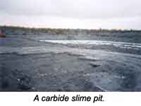Kemgas Will Build PCC Plant in Germany

The first agreement is a 21-year supply contract with Germany's Mitteldeutsche Sanierungs und Entsorgungsgesellschaft mbH (MDSE) for carbide lime. MDSE's acetylene unit produces carbide lime in Schkopauas a byproduct and stores it in a waste pond.
Kemgas has also taken an option on a 13,000 m<> site in an industrial park 12 km from Schkopau, and says it has reached an agreement for pipeline supply of CO2 (>90% purity) from an adjacent Linde AG syngas reformer.
The company has also signed a joint-venture agreement with Norway's Odda Smelteverk AS to process Odda lime, a black waste product from dicyandiamide production, into high-quality PCC.
Raw Materials
MDSE is a daughter of the Bundesanstalt fur vereinigungsbedingte Sonderaufgaben (BvS), the German government agency responsible for managing the environmental legacy of Eastern Germany. BvS sees the Kemgas agreement as an opportunity to reuse waste rather than remove it under a landscape recovery plan.
 MDSE's Schkopau waste dump stretches over 300 hectares, divided into seven ponds. Kemgas is interested in Pond 1. It estimates the pond, which covers 20 hectares, contains more than 700,000 mt of carbide lime.
MDSE's Schkopau waste dump stretches over 300 hectares, divided into seven ponds. Kemgas is interested in Pond 1. It estimates the pond, which covers 20 hectares, contains more than 700,000 mt of carbide lime.
Kemgas also signed an option for a 13,000 m2 site in the InfraLeuna industrial estate, only 12 km away from the Schkopau dump. It is a modern and fully serviced industrial park.
The Leuna location is near a refinery containing a methanol plant. Linde reforms refinery syngas for methanol production and hydrogen separation. The process yields tens of thousands of tons of CO2 byproduct gas, which Linde vents into the atmosphere. Kemgas says it has reached an agreement with Linde for pipeline supply of better 90% pure CO2 to the Kemgas battery limit.
The agreements enable Kemgas to prepare its application to submit a capital grant claim from the German federal state of Sachsen-Anhalt, the home state of the Kemgas project. Kemgas says a government agency, Wirtschaftsforderungsgesellschaft für das Land Sachsen-Anhalt mbH (WISA), has indicated that the grant could cover up to 47% of the capital cost of the PCC project.
"This project provides an innovative way of dealing with the past environmental damage," says MDSE managing director Harald Roetschke. "Kemgas is not only giving us valuable support in remediating the landscape, but they will also create employment for our region and supply a much needed product for the industry."
"At Schkopau we have found the ideal conditions for our project," explains Kemgas marketing and sales director Marc Janssens. "Here, we profit from low transportation costs, since we will have all necessary raw materials practically on site, and from very favorable government grants at the same time."
Kemgas Process
The planned Kemgas plant will produce both slurry and dry PCC for sale in Germany and neighboring countries. Germany is Europe's largest producer of coated paper and the leading consumer of white pigment in the non-paper segments of the PCC market, which command a substantially higher price.
The Kemgas process converts carbide lime (calcium hydroxide), an acetylene byproduct, into PCC through batch crystallization. Until now, no chemical plant has been able to use the highly contaminated acetylene byproduct as a feedstock.
While Kemgas is vague on the solution to contamination problems, it has provided details on its segmented flow tubular reactor. A key element in its technology package, the reactor shoots microbatches of particles through the system. Micropulses eliminate batch-to-batch variation and ensures superior product uniformity. The length of the reactor and flight time within it determine particle size.
According to Kemgas, the technology produces a very high grade of precipitated calcium carbonate. This could pose a challenge to Minerals Technologies Inc. (New York, NY), which operates more than 50 small "satellite" PCC plants around the world. Most of the plants operate on paper production sites and produce a very dilute grade of PCC for paper coating use. PCC is generally used in newer alkaline paper process for both coating and filler.
Odda Smelteverk
The company's recently announced joint venture with Odda Smelteverk capitalizes on the ability of its process to handle highly contaminated feedstocks. Odda lime is contaminated enough to take on a black color. Previous attempts to recycle it into PCC have proven unsuccessful because the resulting particles were not white enough for commercial use.
Last year, Kemgas processed Odda lime at its demonstration plant in the United Kingdom, producing superior quality PCC. "I am impressed with the purity of the product," says Odda director Gunnar Ostby. "This has created interest in the paper industry."
Kemgas recently shipped a demonstration reactor to Odda, and Kemgas technical director Joos Gerlings is working on site to support the program. Once demonstrated on site, the joint venture will build a small, 20,000 mt/yr facility. They expect to follow this in 2001 with a full-scale plant with capacity for 40-50,000 mt/yr of PCC. The partners expect to build a second, similarly sized plant in the future.
According to Kemgas, Norway manufactures more than 2 million mt/yr of paper, but consume virtually no PCC because local production is unavailable. The proposed joint venture will market and sell PCC primarily in Norway and other Scandinavian countries. It also expects to sell outside the region, and into selected markets covered by Odda's parent company, Philip Brothers Chemical Inc.
Phillip Brothers acquired Odda from BOC Group in 1998. Odda is a leading global producer of calcium carbide and dicyandiamide.
For more information: Marc Janssens, Director, Marketing and Sales, Kemgas Ltd., BP 31, 13 chemin du Levant, 01211 Ferney-Voltaire, France. Phone: 011-33-450-428-095. Fax: 011-33-450-405-961.
By Alan S. Brown
